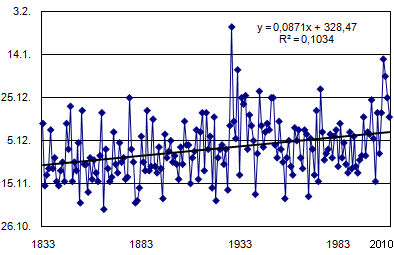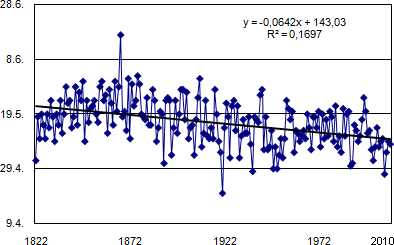Press release 2011-01-17 at 12:00
In a country of 187 888 lakes, it is no wonder that long data series exist on lake ice variables – particularly because all those water bodies freeze every winter, states Dr Esko Kuusisto, Leading hydrologist of Finnish Environment Institute at the Symposium on Climate Change & River Basin Management on 18 January at the University of Oulu. The longest continuous observation series on break-up begins in 1822 (Lake Kallavesi), on freezing in 1833 (Lake Kallavesi) and on ice thickness in 1909 (Lake Muurasjärvi).
– A much longer data series is available on the freeze-up of River Tornio, it starts as early as in 1693, states Dr Kuusisto.
Unlike river ice, lake ice is virtually unaffected by man's actions in watercourses and river basins. Only exceptionally do e.g. thermal effluents, a road embankment or heavy regulation alter lake ice conditions to a certain degree. Thus the nature's fingerprint in lake ice is very pure – a fact which offers many possibilities in climate change research.
Significant trends of ice series
|
Freezing date of Lake Kallavesi 1833-2009
|


|
|
|
|
Break-up date of lake Kallavesi 1822-2010
|


|
|
|
Lake Kallavesi is located in eastern Finland at the latitude of 63N. According to the linear trends fitted to the whole series, the freezing date has shifted 15 day later in 1833–2009, while the break-up date has shifted 12 days earlier in 1822–2010. Both trends are significant at the level of 99.9 per cent.
At sub-series level, very different trends could be found from these series. E.g. the shift towards later break-up in 1822–1867 is 14 days, significant at the level of 99.9 per cent. If this trend would have continued as such, the expectancy for the break-up date in 2008 would have been July the 8th. As to the freezing date, the trend in 1987–2008, significant at the level of 95%, is as high as 26 days for that short period.
At Lake Oulujärvi, ice observations started in the winter of 1854–1855. During 156 winters, the freezing date has shifted nine days later and the breakup date eleven days earlier. The extremes of freezing have been October 22nd (1894, 1902) and December 24th (1929), those of break-up May 3rd (1921) and June 23rd (1867).
As to the thickness of lake ice, some long series from observation sites in southern and central Finland have indications of a thinning trend, some in the northern Finland of a thickening trend until 2002 (Korhonen, 2005). In recent years, lake ice has been relatively thin in the north, while the thickest ice in the whole observation series at almost all measuring sites in southern Finland was observed in the winter 2002–2003.
How will ice conditions develop in Finnish lakes in the future?
Climate change will inevitably be a powerful agent. Ice break-up will occur earlier, freezing will occur later and the ice cover period will be shorter. The effects will be stronger in the south than in the north. E.g. Weyhenmeyer & al (2005) found the breakup date to shift around 14 days earlier per 1°C rise in air temperature in southern Sweden, but only 4 days per 1°C rise in northern Sweden.
The effects of climate change on the maximum ice thickness will not be straightforward. Ice thickness depends on both temperature conditions and snowfall. Increased snowfall could increase snow ice and this way also increase total ice thickness. Probably the maximum ice thickness will decrease in the south but in the north an opposite trend is possible, at least in the next one or two decades.
References
Korhonen, J., 2005. Ice conditions in lakes and rivers in Finland. The Finnish Environment 751, 145 p. (in Finnish with a summary in English).
Weyhenmeyer, G. A., Meili, M. & Livingstone, D. M., 2005. Systematic differences in the trend toward earlier ice-out on Swedish lakes along a latitudinal temperature gradient. Verhandlungen der internationalen Vereinigung der Limnologie 29(1): 257-260
Further information
Dr Esko Kuusisto, Finnish Environment Institute SYKE,
mobile + 358 40 831 9165
e-mail address format: firstname.surname@ymparisto.fi